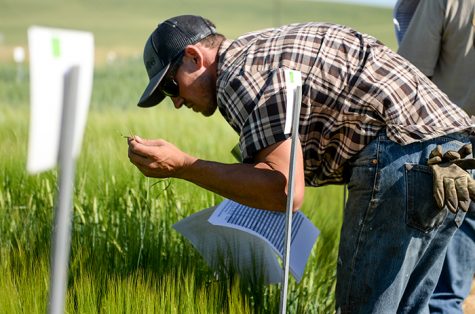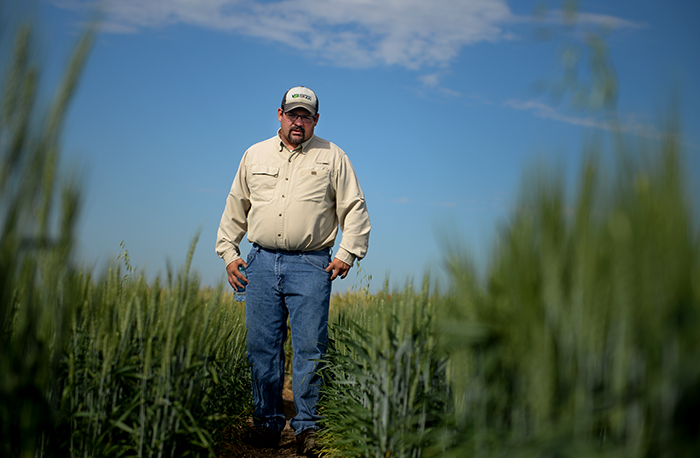Local wheat growers may face second bad year
Weather in late June suggests wheat could have quality issues again this season
CODY COTTIER | The Daily Evergreen
WSU wheat breeder Michael Pumphrey stands among test plots at the Spillman Agronomy Farm. He grows varieties to resist issues like low falling numbers, a defect that cost Washington farmers millions of dollars last year.
July 12, 2017
Recent temperature fluctuations could signal another year of starch damage for local wheat growers, following a crop with widespread quality issues that collectively lost Washington farmers tens of millions of dollars.
WSU wheat breeder Michael Pumphrey said when temperatures soar during the day and drop sharply at night, wheat produces an enzyme that degrades its starch and lowers its quality below industry standards. He said some areas saw highs in the 90s and lows in the 40s in the last week of June.
“Exactly where we’d have problems is hard to predict,” he said, “but I would suspect that we did have another sort of outbreak like 2016 just the past couple weeks.”
Though Pumphrey emphasized that everything is speculation at this point, he said the weather has been very similar to last year when many Palouse growers’ crops had problems.
The measurement of a wheat’s starch damage is called its falling number, the amount of time it takes a plunger to fall through a sample of flour mixed with water. Anything below 300 is generally considered unsuitable for baking, and many crops fell in the 175-225 range, Pumphrey said.
Customers around the Pacific Rim, in countries like Japan, Taiwan and South Korea, are the region’s largest wheat market. Most will not accept unhealthy wheat at full price, making it near impossible for farmers to break even. Loss estimates for the state in 2016 exceed $30 million.

Wheat farmer Dominic Ingwaldson examines wheat from a WSU test plot north of Colfax.
Ryan Kile, branch manager for Northwest Farm Credit Services in Colfax, said the level of concern about a second year of bad crops varies.
“It’s in pockets,” Kile said. “Some guys are pretty nervous about it, but others just have a hard time believing it would happen two years in a row.”
He said many of his customers didn’t feel the recent temperature swings were as significant as last year, adding that he does not know of a time when two consecutive years brought such severe problems.
“I think it’ll feel like the sky’s falling if that does happen,” he said. “But I think the odds are hopefully in our favor that it doesn’t happen.”
To some extent, it does come down to odds. Different varieties are more prone to low falling numbers in different areas, and though research is helping to reveal which wheat works where, the predictions still lack precision.
In addition, a highly damaged crop can appear healthy. Ben Barstow, a wheat farmer, said he was lucky he grew Crescent wheat last year when many planted Ovation, a seemingly robust variety that was in reality highly susceptible to low falling numbers.
“It looks like a perfectly sound kernel,” Barstow said. “Everything is perfect except the chemistry.”
There is little farmers can do beyond selecting the right varieties. Some store their grain in a bin, hoping the falling number will increase. But with much left to learn about which varieties flourish in which locations, there is not yet a surefire way to guarantee a good harvest.
“You just take what you get and hope for better the next year,” Barstow said.
“Hard to tell where the chips will fall this year,” wheat farmer Burgess Lange added.
Pumphrey recommends farmers plant multiple varieties that mature at different times, to reduce the risk of losing an entire crop to low falling numbers. He and other researchers are working to breed resistant wheat, and he said they are starting to build a good baseline for informing growers of the falling numbers of different varieties.
He said farmers could benefit from more immediate testing for low falling numbers as well. Now they must send wheat samples to a lab for analysis, and the results typically don’t come back until they have already delivered their grain.
If they knew beforehand which wheat was healthy, they could sell that without mixing in the damaged wheat.
“At that point, it’s not a one-to-one thing,” Pumphrey said. “A bad lot of grain in an otherwise really good lot of grain still spoils the whole pot.”
Low falling numbers resulting from temperature fluctuations is a fairly recent phenomenon. The problem can also arise due to pre-harvest sprouting, which occurs when wheat gets wet near harvest. Last year’s widespread damage, however, was due to late-maturity alpha amylase, an enzyme caused by dramatic temperature swings.
Many susceptible varieties have been grown widely in the region for years, Pumphrey said, adding to the confusion about why the problem has only recently become prominent. Many growers likely hadn’t experienced low falling numbers until last year, he said.
“[This] is the one that has really had farmers and scientists scratching their heads,” Pumphrey said.
The problem comes at a time when wheat prices are already down, Kile said. As the cost of farming increases, many farmers struggle to make money, especially last year after receiving deductions for low falling numbers.
“Financially, it did have a pretty devastating impact on a lot of growers,” Kile said. “Most growers can’t afford another bad year.”










